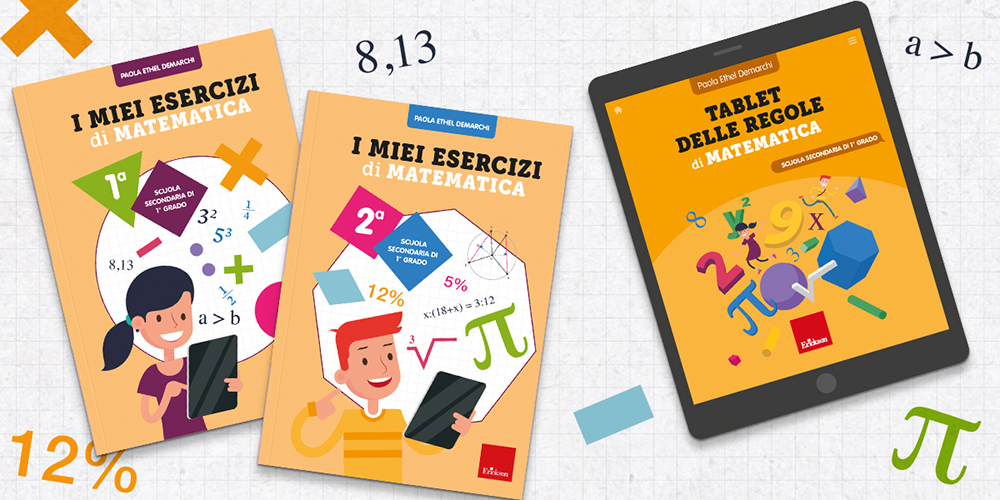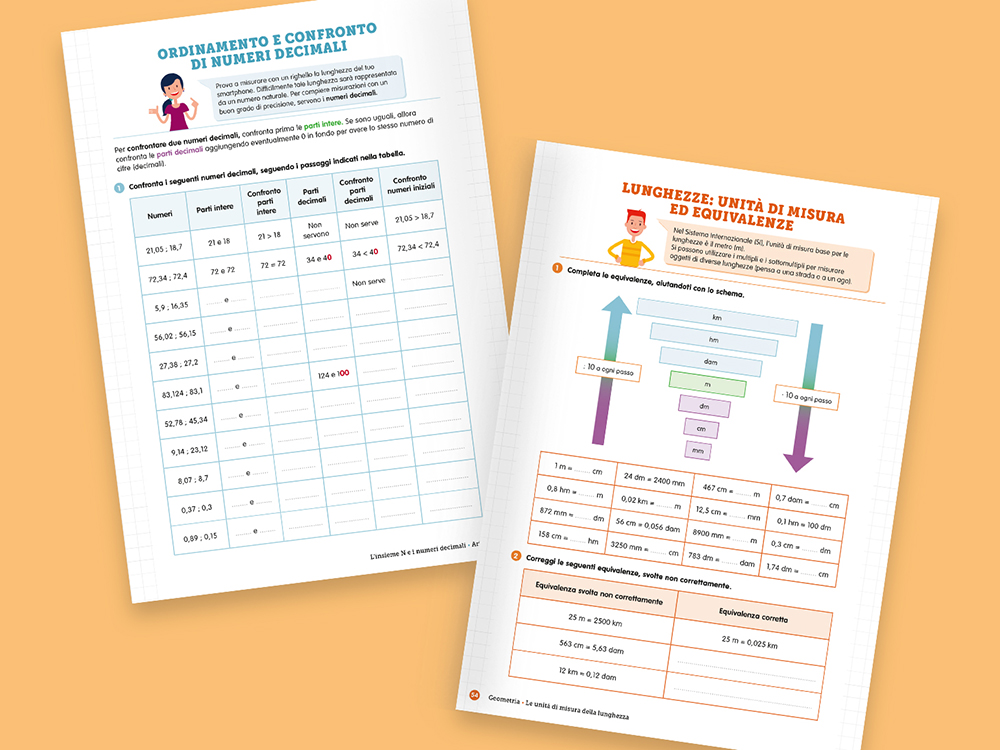 EN
EN
 PT
PT
Lower secondary school - Third year
Product: Book
Trim size in cm: 21x27cm
Pages: 80
ISBN: 9788859028178
Publication date: 01/05/2022
Suitable for: Lower secondary 2nd level (ages 12-13)
REQUEST A SAMPLE OR MORE INFORMATION
This volume, an operational declination of the Tablet of maths rules, supports students in the third year of lower secondary school with resolving mathematics exercises, proposing some strategies and tools for schematization and facilitations:
How the notebook is structured
In each unit, a comic introduces the topic and a brief summary reviews the fundamental concepts, which, if necessary, can be explored in the corresponding chapter of the Tablet of maths rules.
The proposed exercises are initially guided step by step, to help reflect on the mathematical concepts involved in them and on the relationships between the various steps used. Proceeding within the unit, the guided steps decrease to leave the student more autonomy in finding the solution.
In each unit, problems applied to concrete situations find ample space, so that students can realize the importance of mathematics in the interpretation of reality.
INTRODUCTION
ARITHMETIC AND ALGEBRA
Set Z and Set Q
Z: ordering and comparing
Z: addition and subtraction with whole relative numbers
Z: multiplication and division with whole relative numbers
Z: exponents with whole relative numbers and their properties
Set Q
Scientific notation
Monomials and Polynomials
Monomials and polynomials
Algebraic addition with monomials
Multiplication with monomials
Division with monomials
Exponents with monomials
Expressions with monomials
Algebraic addition with polynomials
Multiplication with polynomials
Notable products
Expressions with polynomials
Linear equations
Linear equations with integers and principles of equivalence
Resolution of a linear equation
Problems with linear equations
STATISTICS AND PROBABILITY
Population statistics and characteristics
Absolute, relative and percentage frequency
Position indices: mean, mode, median
Range of variation
Data representation
Compatible, incompatible and complementary probabilities and events
Intersection and union of two events
Probability of independent events
Probability of dependent events
GEOMETRY
Planar geometry
The circle and circumference
The Cartesian plane: points on a plane and the distance between two points
Solid geometry
Volume and units of measurement: equivalences
The prism: problems with area and volume
The rectangular prism: problems with area and volume
The cube: problems with area and volume
The pyramid: problems with area and volume
The cylinder: problems with area and volume
The cone: problems with area and volume
The sphere: problems with area and volume


The tablet notebooks follow the publication of The tablet of Math rules and are dedicated to lower secondary school students! Each workbook provides exercises and problems on all the topics studied during the first, second and third years at school, in order to consolidate and explore them thoroughly. Together with the Tablet of Math rules, these volumes are an immediate and easily accessible tool to support learning.
Exercises on each topic are preceded by a short and clear explanation, with examples and strategies for calculation and problem solving. Students will be accompanied through the activities, with the help of useful advice and some tips.

Tools for learning
Each volume in the series provides some schematic and facilitation tools:
My Mathematical Exercises First Year
ARITHMETICS: the set N and decimal numbers (ordering and comparing whole numbers and decimal numbers, the four operations and their properties, properties of powers, expressions, breaking down numbers into prime factors, GCD and lcm); the set Q+ (ordering and comparing fractions, operations with fractions, powers of fractions, expressions).
GEOMETRY: the primitive geometric entities (lines, rays, segments and angles); the units of length; polygons and calculation of the perimeter; geometric transformations (translations, rotations, symmetries).
Leaf through some pages of the volume which have been translated into English to facilitate your evaluation of the product:
My Mathematical Exercises Second Year
ARITHMETICS: the set Q+ (transformation of fractions into decimal numbers and vice versa, rounding of a decimal number); the set I (root extraction of a number, irrational numbers); proportions (proportions and their properties, problems with proportions, direct and inverse proportions, simple three and compound three problems); percentages (percentages and problems with percentages).
GEOMETRY: the units of surface area; polygons and calculation of area (regular and irregular geometric figures); Pythagoras' Theorem; Euclid's Theorems; similar polygons; homotypes; the circle and inscribed and circumscribed polygons.
Leaf through some pages of the volume which have been translated into English to facilitate your evaluation of the product:
My Mathematical Exercises Third Year
Arithmetic and algebra: set Z and set Q (properties and operations with relative integers, set Q and scientific notation); monomials and polynomials (operations and expressions with monomials and polynomials); first degree equations (equations, equivalence principles and problems).
Statistics and probability: statistical populations; absolute, relative and percentage frequency; position indices; data representation; compatible, incompatible and complementary probabilities and events; intersection and union of two events; probability of independent and dependent events.
Geometry: planar geometry (circumference and circle, Cartesian plane); solid geometry (prism, rectangular pyramid, cube, pyramid, cylinder, cone and sphere).
Leaf through some pages of the volume which have been translated into English to facilitate your evaluation of the product:
THE AUTHOR
Paola Ethel Demarchi A graduate in Mathematics from the University of Turin, she specialized in support activities for pupils with disabilities in secondary schools and obtained a first-level master's degree in Didactics and Psychopedagogy for Learning Disorders. Author of scientific texts and articles, she teaches mathematics in secondary schools.